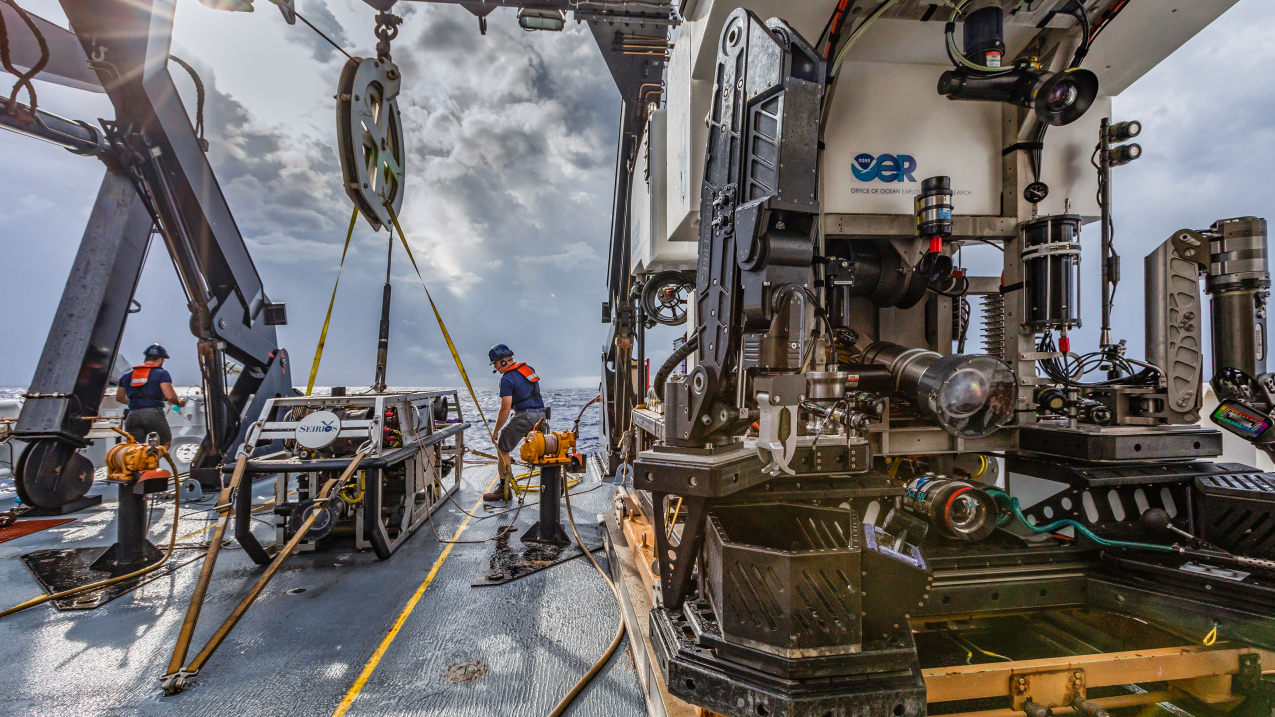If it weren’t for our satellites, buoys, planes, and ships, NOAA wouldn’t have nearly the amount of data it does today. That’s why technology and innovation are key ingredients for cutting-edge science. In this collection of lessons, mobile apps, videos, data, and more, you can learn how NOAA uses technology and engineering to get the job done.

The remotely operated vehicle Deep Discoverer (left; on the deck of NOAA Ship Okeanos Explorer) will be used to image unexplored areas of the Blake Plateau, Blake Ridge, Blake Escarpment, submarine canyons offshore of North Carolina, submerged cultural heritage sites, areas predicted to be suitable habitat for deep-sea corals and sponges, intercanyon areas, and gas seeps. 2019 photo. (Image credit: NOAA OER)
NOTE: This page is no longer being updated or maintained.
You can find more technology and engineering resources and much more in our Sea to Sky database. You can bookmark this link, which will take you directly to the Sea to Sky database with technology and engineering as a topic pre-selected. You can further refine by subject, topic, or other filters as needed.
Curricula, lessons, and activities
3D-printed model brings coral education to life
K - 12th grade
This generic 3D coral polyp model shows a cross section of a single polyp, including its tentacles, gastrodermis, stomach cavity, and the complex skeletal structure underneath.
Clean Collection: Engineering, technology, and applications of science offsite link
5th - 12th grade • Teacher guide • Links to standards
Explore dozens of lessons on climate and energy topics related to engineering and technology. Lessons are searchable by grade and NGSS concepts.
Discover your changing world with NOAA
2nd - 9th grade • Links to standards
This activity book explores climate, climate change and its impacts, and what you can do to explore, understand, and protect our Earth. Activities 1, 2, 4, and 5 involve building and engineering.
Discover your world with NOAA
2nd - 9th grade
This activity book dives into a broad range of NOAA topics. The following activities involve building and engineering: Boat building challenge, Make your own astrolabe, Make your own compass, Build an underwater robot, Make your own volcano, and Build your own volcano.
Deep-sea corals and remotely operated vehicles (ROVs) offsite link
9th - 12th grade • Teacher guide • Links to standards
This lesson focuses on the species found in deep-sea coral communities, the threats that face them and what individuals and communities can do
help protect them. Students use data from scientific transects taken with remotely operated vehicles (ROVs).
Engineering biodegradable drifters offsite link
6th - 8th grade • Teacher guide • Links to standards
In this activity, students engineer drifter buoys to demonstrate how trash found in inland waterways can move through the watershed and become marine debris. More lessons from this STREAMSS curriculum for 4th through 12th grade can be found here offsite link.
Enrichment in marine sciences and oceanography curriculum
9th - 12th grade • Teacher guide • Links to standards
This curriculum includes two lessons on different technologies used in marine science research.
GPS STEM curriculum
6th - 12th grade • Teacher guide • Links to standards
This modular curriculum introduces global positioning system (GPS) technology and how it is used in different ways. These lessons follow modern pedagogy techniques.
Identifying clouds on satellite images simulation
5th grade - undergraduate
This online activity uses archived Weather Surveillance Radar (WSR-88D) data, severe weather reports, and damage survey photographs from actual events to show some of the National Weather Service's process when issuing severe weather warnings.
National Geodetic Survey lessons
11th grade - undergraduate
These self-paced lessons introduce geodesy and remote sensing.
Maritime archaeology lesson plans
6th - 12th grade
This collection of lessons and other resources includes information about the technologies used to study maritime archaeology.
Phenomenon-based learning from NOAA Science on a Sphere
K - 12th grade • Teacher guide • Links to standards
This collections of modules use Science on a Sphere (SOS) datasets to help explore and explain science phenomena. Each topic includes guiding questions and links to specific datasets.
Remotely operated vehicles (ROV) curriculum offsite link
6th - 12th grade • Teacher guide • Links to standards
This curriculum introduces students to remotely operated vehicles (ROV) and careers in marine science and underwater archaeology. Students learn the science behind an ROV, solve real world problems, and explore the engineering design process.
Satellites and weather teaching box offsite link
5th - 8th grade • Teacher guide • Links to standards
These lessons explore how environmental satellites work and how we can use data from them to improve weather monitoring and prediction.
Underwater robot education theme
6th - 12th grade • Teacher guide • Links to standards
Underwater robots, such as remotely operated vehicles (ROVs) and autonomous underwater vehicles (AUVs), are essential tools for ocean exploration. These robots can explore areas of the ocean that are too dangerous or too difficult for humans to go. Underwater robots come in a variety of shapes and sizes and can be outfitted with numerous sensors and tools to collect extensive amounts of data from deep-sea environments. Explore more with these lessons, videos, background reading, and more.
Mobile apps
CrowdMag
Use mobile devices to help create models of Earth's magnetic field.
Get started with our tiny tutorial!
Meteorological Phenomena Identification Near the Ground (mPING)
Citizen scientists around the world can submit weather observations and view reports.
Science on a Sphere (SOS) Explorer
Bring beautiful visualizations of global data into the palm of your hand.
SeaPhoto offsite link
Explore hundreds of photos of Californian marine life, many with detailed ecological information.
Whale Alert offsite link
Protect whales by using this app while at sea or reporting whale sightings. Educators may enjoy using this app to view local whale reports.

